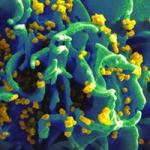
Dima A. Hammoud, M.D.
Senior Investigator
Center for Infectious Disease Imaging (CIDI)
NIH Clinical Center
Research Topics
The Hammoud lab in the Clinical Center (CC) focuses on the development of preclinical, translational, and clinical molecular imaging applications to improve the understanding of infection pathophysiology and provide reliable imaging biomarkers of infectious diseases.
Current research in the laboratory focuses on the development and validation of novel fungal-specific imaging biomarkers in animal models using non-invasive molecular imaging techniques, mainly positron emission tomography (PET), as well as their translation to human applications.
Another interest of the lab is utilizing molecular imaging to better understand the pathophysiology of HIV in the brain and periphery, and to identify HIV reservoirs. Dr Hammoud also collaborates with investigators at the National Institute of Allergy and Infectious Diseases (NIAID) to image high-consequence viral infections such as Ebola, Nipah and Lassa viruses.
Biography
Dr. Hammoud is tenured senior investigator and Chief of the Neuroradiology Section in CC-Radiology and Imaging Sciences (RADIS). Dr Hammoud is board-certified in diagnostic imaging by the American Board of Radiology and has completed fellowships in neuroradiology and PET imaging. She is the deputy director of the Center for Infectious Disease Imaging (CIDI, a joint initiative between the CC and NIAID). She has served as Chair of the scientific program committee for the 2025 World Molecular imaging Congress (WMIC), chair of the "Imaging of Infections” (IOI) interest group at WMIS, ACUC Chair at the NIH-CC, Vice-Chair of Neurosciences (Brain imaging council) at SNMMI and Board Member of SNMMI CMIIT Center of Excellence (COE) Program Task Force. She has >140 peer-reviewed publications, 7 book chapters, and has won multiple awards including the 2024 NIH Director’s award for her work on imaging fungal infections.
Selected Publications
- Shah S, Lai J, Basuli F, Martinez-Orengo N, Patel R, Turner ML, Wang B, Shi ZD, Sourabh S, Peiravi M, Lyndaker A, Liu S, Seyedmousavi S, Williamson PR, Swenson RE, Hammoud DA. Development and preclinical validation of 2-deoxy 2-[(18)F]fluorocellobiose as an Aspergillus-specific PET tracer. Sci Transl Med. 2024;16(760):eadl5934.
- Lai J, Shah S, Martinez-Orengo N, Knight R, Alemu E, Turner ML, Wang B, Lyndaker A, Shi J, Basuli F, Hammoud DA. PET imaging of Aspergillus infection using Zirconium-89 labeled anti-β-glucan antibody fragments. Eur J Nucl Med Mol Imaging. 2024;51(11):3223-3234.
- Martinez-Orengo N, Shah S, Lai J, Basuli F, Lyndaker A, Turner ML, Peiravi M, Sourabh S, Sampson K, Zhang P, Swenson RE, Lusso P, Maldarelli F, Nath A, Lau CY, Hammoud DA. PET imaging of HIV-1 envelope protein gp120 using (18)F-labeled nanobodies. iScience. 2025;28(2):111795.
- Shah S, Sinharay S, Patel R, Solomon J, Lee JH, Schreiber-Stainthorp W, Basuli F, Zhang X, Hagen KR, Reeder R, Wakim P, Huzella LM, Maric D, Johnson RF, Hammoud DA. PET imaging of TSPO expression in immune cells can assess organ-level pathophysiology in high-consequence viral infections. Proc Natl Acad Sci U S A. 2022;119(15):e2110846119.
- Schreiber-Stainthorp W, Solomon J, Lee JH, Castro M, Shah S, Martinez-Orengo N, Reeder R, Maric D, Gross R, Qin J, Hagen KR, Johnson RF, Hammoud DA. Longitudinal in vivo imaging of acute neuropathology in a monkey model of Ebola virus infection. Nat Commun. 2021;12(1):2855.
Related Scientific Focus Areas

Microbiology and Infectious Diseases
View additional Principal Investigators in Microbiology and Infectious Diseases


This page was last updated on Tuesday, September 23, 2025